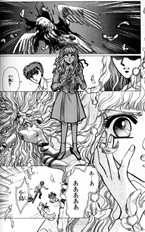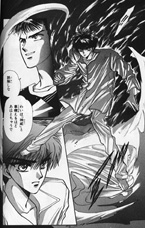
Manga and anime are related, but they are significantly different media with very different ways of enclosing concepts and ideas. Taking X as an example, the layout and presentation of the story are far beyond what could be expressed in an anime. In Exhibit A, Kotori (the little girl) sees, lying on the ground, a bird that has been run over by some motor vehicle. This sight brings back the traumatic memory of seeing her dead mother's dismembered body parts and internal organs splattered around a room, simplified in her memory and depicted by the mannequin-like dismembered female to her left. Actually, Kotori is much older now and is remembering the experience of seeing the bird and then remembering her mother. In just one visual image, the nested mental links related to her traumatic memory are expressed with the image of the bird and her mother, with images of the scene interlaced to show the relationship to the young boy (Kamui, the main character), and the entire page is centered around her younger self, drawn to indicate her emotional state.
